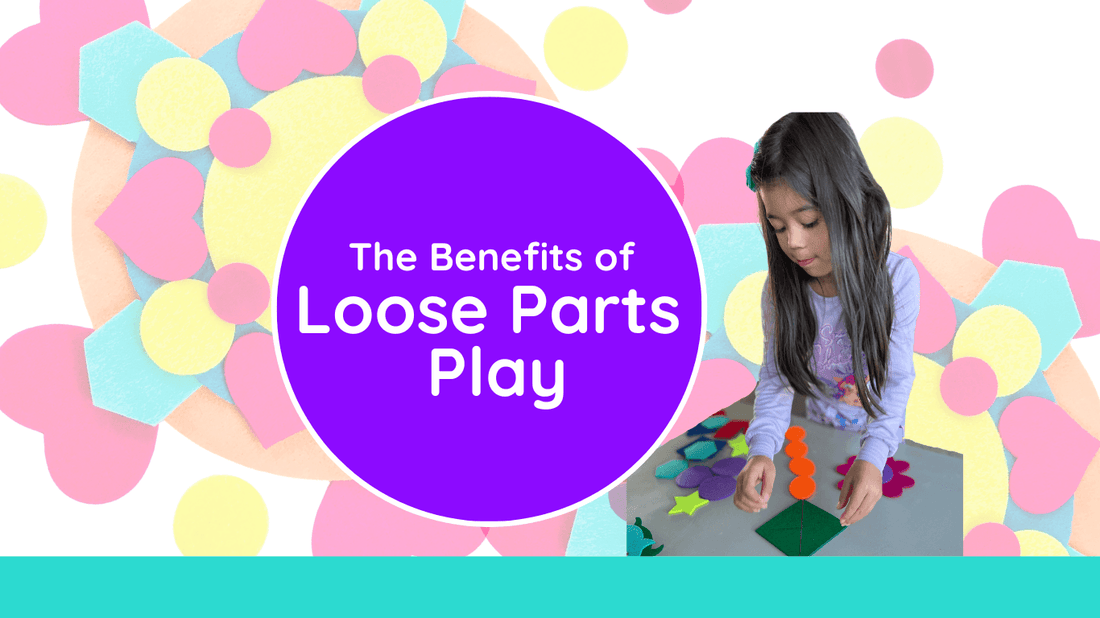
Benefits of Loose Parts Play
Share
You may have heard early childhood educators or fellow parents referring to something known as “loose parts play”, but what exactly is this and what are the benefits?
Loose parts play is an activity involving open-ended materials that can be moved, manipulated, and combined in various ways to create something new.
These materials may include sticks, pebbles, felt pieces, shells, marbles, feathers, leaves, cardboard, plastic lids, or pretty much anything else that children can find to use in their play. 
Not only is this an interesting way for kids to enjoy the tactile experience of creatively experimenting with their hands, but loose parts play can also support the physical, cognitive, and social-emotional development of young learners by allowing them to freely use their imaginations, develop their creativity, and work collaboratively in an unstructured and open-ended way.
In today's world, children are spending more time on screens than ever before. With the rise of technology and sheer convenience of handheld devices and gadgets, it is becoming increasingly difficult to encourage kids to engage in screen-free activities.
Studies have shown, however, that excessive screen time can have a negative impact on children's development, affecting their physical, cognitive, and emotional wellbeing.
While there are some apps and games that may encourage problem-solving skills, they are often structured and have predetermined outcomes.
"Children are not necessarily using their imaginations and thinking creatively when using digital programs."
Says Candice Kindergarten Teacher of 14 years and Mom of 2.
That is why it is essential that we as parents provide our kids with hands-on activities that support creative development, imagination, and social skills.
Loose parts play gives children opportunities to actively practice thinking for themselves, taking risks, and thinking outside the box in order to create something new.
It can also support the development of hand-eye coordination, critical thinking, and collaborative play. Let's explore some of the benefits of loose parts play in more detail.
Hand-Eye Coordination
Hand-eye coordination is an essential skill that helps children perform everyday tasks, such as writing, colouring, getting dressed, and playing sports.
Loose parts play involves manipulating small objects, fitting pieces together, and using tools, which can all play a role in helping children improve their fine motor skills.
When a child picks up a series of stones, for example, and purposefully arranges them to look like the petals of a flower, they are developing hand dexterity and control. By creating a specific scene or image composed of a series of varied parts, they are learning to coordinate their hands and eyes to achieve a specific goal.
Critical Thinking
Critical thinking is the ability to analyze information, evaluate arguments, and solve problems; it is essential for a young person’s intellectual and social-emotional development.
Dinosaur Small World Play Set is a great foundation for loose parts play
Critical thinking enables children to make decisions independently using logic and sound reasoning. It is also a skill that supports effective communication as kids learn to both express their ideas while also listening thoughtfully to the opinions of others.
Moreover, critical thinking allows them to evaluate their own ideas and seek feedback from others to improve their understanding.
"By fostering these skills in children, we ultimately help them become confident and successful learners who are well-prepared for the challenges of the future."
Loose parts play can help children develop critical thinking skills by encouraging them to experiment, explore, and make connections.
Unlike structured toys that have a specific purpose or an end goal, loose parts play materials do not have a defined use.
This encourages children to think “outside the box” and use their own unique experiences to come up with different ways to represent the materials. For example, they may use elements from nature like sticks and rocks to construct the faces of their family members.
Loose parts play encourages little ones to take one thing and turn it into something completely different or even unexpected. Children can experiment with a myriad of shapes, colors, and textures, and figure out how to create something new and by doing so, they are unconsciously nurturing the development of problem-solving skills, logical thinking, and decision-making abilities.
Collaborative Play
Collaborative play is an essential social skill that helps children learn how to work together, communicate effectively, and respect one another’s opinions.
Loose parts play can foster collaboration by encouraging children to share not only the physical materials, but the ideas and techniques as well.
Since there are no set rules, children are able to work together to create something innovative and unique to their own interests.
They can use loose parts play as an opportunity to share their knowledge, learn from each other, and work towards a common goal. This is both a natural and enjoyable way to encourage teamwork.
Tips for Encouraging Loose Parts Play
Here are 5 simple tips for encouraging loose parts play with your children:- Provide a variety of materials for your children to explore. These materials can include blocks, natural objects like sticks and stones, recycled materials like pieces of felt or fabric, and playdough or clay.
- Encourage your children to create something new with pieces you already have around the home. Show them how everyday objects can be turned into something entirely different than what is expected simply by examining them through a different lens.
- Follow the child and let your kids lead the play. Give them space to experiment and explore with the materials on their own without dictating how they should use them.
- Join in the play and explore with your children. This can be a great opportunity for you to bond with your kids and learn more about their interests and perspectives.
- Set up loose parts play in different environments, such as the bathtub, the kitchen, or even the backyard. This can help your child learn about the different properties of the materials and how they can be used in different ways.
In conclusion, loose parts play is a valuable tool for promoting children's physical, cognitive, and social development.
It encourages children to use their imaginations, develop their creativity, and work collaboratively.
This type of play also offers screen-free opportunities for children to engage in open-ended explorations and develop their problem-solving skills.
By providing children with materials and encouraging them to explore and experiment, parents and caregivers can unlock their children's learning potential and promote their overall development and wellbeing.
Check out some of these fun educational toys that give children the opportunity to benefit from loose parts play.


